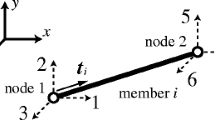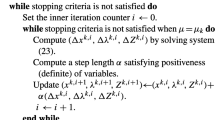Abstract
In this paper, we present an enhanced growth method based on virtual displacements and strains fields for generating optimal design in terms of topology and geometry of plane trusses without the need of a generation of so-called ground structure. The method has been applied to the single load case problem with stress and size constraints in plastic design. In order to demonstrate the reliability and accuracy of the proposed method, three examples are carried out: Hemp cantilever, Chan cantilever and McConnel structure.















Similar content being viewed by others
Notes
The algorithm allows for using different values of \(\sigma _T\) and \(\sigma _C\), but for the sake of simplicity of presented examples it was assumed that both of these values are equal to \(\sigma _{ 0 }\).
References
Achtziger W (1997) Topology optimization of discrete structures. In: Rozvany GIN (ed) Topology optimization in structural mechanics, vol 374. International Centre for Mechanical Sciences (Courses and Lectures). Springer, Vienna, pp 57–100
Achtziger W (1998) Multiple-load truss topology and sizing optimization: Some properties of minimax compliance. J Optim Theory Appl 98(2):255–280
Achtziger W (2007) On simultaneous optimization of truss geometry and topology. Struct Multidisc Optim 33(4–5):285–304
Chan ASL (1960) The design of Michell optimum structures. Tech. rep, Cranfield College of Aeronautics
Chan HSY (1963) Optimum Michell frameworks for three parallel forces. Tech. rep, Cranfield College of Aeronautics
Dorn WS, Gomory RE, Greenberg HJ (1964) Automatic design of optimal structures. J de Mecanique 3:25–52
Eichhammer E (2018) QCustomPlot 2.0.1 documentation. https://www.qcustomplot.com/documentation/
Fairclough HE, Gilbert M, Pichugin AV, Tyas A, Firth I (2018) Theoretically optimal forms for very long-span bridges under gravity loading. Proceedings of the Royal Society A: Mathematical, Physical and Engineering Sciences 474(2217):20170726
Fairclough HE, He L, Pritchard TJ, Gilbert M (2021) Layopt: an educational web-app for truss layout optimization. Struct Multidisc Optim 64, 2805–2823 . https://www.layopt.com
Gilbert M, Tyas A (2003) Layout optimization of large-scale pin-jointed frames. Eng Comput 20(8):1044–1064
Graczykowski C, Lewiński T (2010) Michell cantilevers constructed within a half strip. tabulation of selected benchmark results. Struct Multidisc Optim 42(6):869–877
He L, Gilbert M (2015) Rationalization of trusses generated via layout optimization. Struct Multidisc Optim 52(4):677–694
Hemp WS (1974) Michell framework for uniform load between fixed supports. Eng Optim 1(1):61–69
Lewiński T, Sokół T, Graczykowski C (2018) Michell structures. Springer
Martinez P, Marti P, Querin OM (2007) Growth method for size, topology, and geometry optimization of truss structures. Struct Multidisc Optim 33(1):13–26
Mazurek A (2012) Geometrical aspects of optimum truss like structures for three-force problem. Struct Multidisc Optim 45(1):21–32
McConnel RE (1974) Least-weight frameworks for loads across span. J Eng Mech 100:10872
Michell AGM (1904) The limits of economy of material in frame-structures. The London, Edinburgh, and Dublin Philosophical Magazine and Journal of Science 8(47):589–597
MosekAps: MOSEK Fusion API for C++. Version 9.2.38. (2021). https://docs.mosek.com/9.2/cxxfusion/index.html
Nocedal J, Wright S (2006) Numerical optimization. Springer Science & Business Media, New York
Prager W, Rozvany GIN (1977) Optimization of structural geometry. Dynamical systems pp. 265–293
Prata S (2011) C++ primer plus. Addison-Wesley Professional
Pritchard TJ, Gilbert M, Tyas A (2005) Plastic layout optimization of large-scale frameworks subject to multiple load cases, member self-weight and with joint length penalties. Proc of 6th World Congresses of Structural and Multidisciplinary Optimization, Rio de Janeiro, Brazil
QtGroup: Qt framework documentation (2021). https://doc.qt.io/
Rozvany GIN (1976) Optimal design of flexural systems: beams, grillages, slabs, plates and shells. Pergamon Press, Oxford
Sokół T (2015) Multi-load truss topology optimization using the adaptive ground structure approach. In: Łodygowski T, Rakowski J, Litewka P (eds) Recent advances in computational mechanics. CRC Press, London, pp 9–16
Sokół T (2017) On the numerical approximation of Michell trusses and the improved ground structure method. In: Schumacher A, Vietor T, Fiebig S, Bletzinger KU, Maute K (eds) Advances in Structural and Multidisciplinary Optimization. WCSMO, Springer, Cham
Sokół T, Lewiński T (2010) On the solution of the three forces problem and its application in optimal designing of a class of symmetric plane frameworks of least weight. Struct Multidisc Optim 42(6):835–853
Wächter A, Biegler LT (2006) On the implementation of an interior-point filter line-search algorithm for large-scale nonlinear programming. Math Program 106(1):25–57
Weldeyesus AG, Gondzio J (2018) A specialized primal-dual interior point method for the plastic truss layout optimization. Comput Optim Appl 71(3):613–640
Williams A (2019) C++ concurrency in action, vol. 2. Manning Publications
Wright SJ (1997) Primal-dual interior-point methods. SIAM, Thailand
Acknowledgements
The paper was prepared within the Research Grant no 2019/33/B/ST8/00325 financed by the National Science Centre (Poland), entitled: Merging the optimum design problems of structural topology and of the optimal choice of material characteristics. The theoretical foundations and numerical methods.
Author information
Authors and Affiliations
Corresponding author
Ethics declarations
Conflict of interest
The authors declare that they have no conflict of interest.
Replication of results
The starting points used to generate all numerical examples are available in the Electronic Supplementary Material.
Additional information
Responsible Editor: Matthew Gilbert
Publisher's Note
Springer Nature remains neutral with regard to jurisdictional claims in published maps and institutional affiliations.
Supplementary Information
Below is the link to the electronic supplementary material.
Rights and permissions
About this article
Cite this article
Kozłowski, G., Sokół, T. Enhanced growth method for topology and geometry optimization of truss structures. Struct Multidisc Optim 65, 220 (2022). https://doi.org/10.1007/s00158-022-03317-7
Received:
Revised:
Accepted:
Published:
DOI: https://doi.org/10.1007/s00158-022-03317-7




